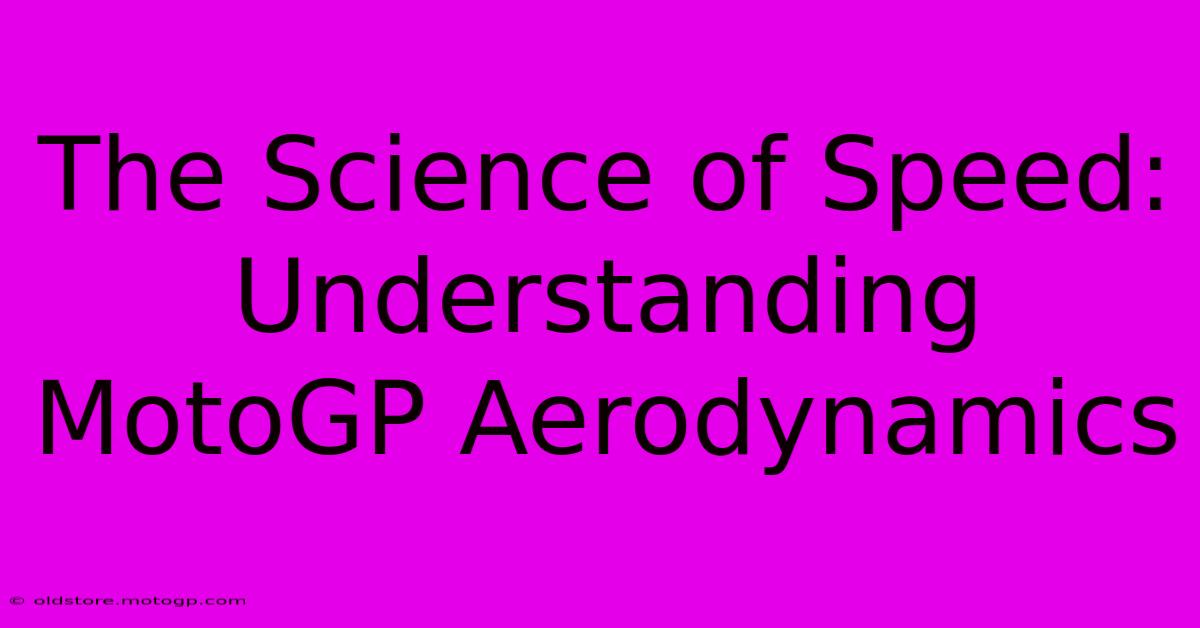The Science Of Speed: Understanding MotoGP Aerodynamics

Table of Contents
The Science of Speed: Understanding MotoGP Aerodynamics
MotoGP, the pinnacle of motorcycle racing, isn't just about powerful engines and skilled riders. A significant, often overlooked, factor contributing to a rider's success is aerodynamics. Understanding how air flows around a MotoGP bike is crucial to unlocking speed and performance. This article delves into the science behind MotoGP aerodynamics, exploring the key elements that determine a bike's ability to cut through the air with minimal resistance.
The Importance of Aerodynamics in MotoGP
At speeds exceeding 200 mph, aerodynamic forces become incredibly significant. Even small improvements in airflow can translate to substantial gains in lap times and overall race performance. MotoGP aerodynamics isn't just about reducing drag; it's also about generating downforce, keeping the bike glued to the track for enhanced cornering stability and braking performance. The pursuit of the perfect aerodynamic balance is a constant arms race between teams, leading to ever-evolving designs.
Drag Reduction: The Fight Against Air Resistance
Drag is the force that resists the bike's forward motion through the air. Minimizing drag is paramount to achieving higher top speeds. Teams employ various strategies to reduce drag, including:
- Streamlined Fairings: The fairings, or bodywork, are meticulously designed to minimize turbulence and create a smooth airflow around the bike. Even small changes to the fairing's shape can significantly impact drag.
- Winglets and Aerodynamic Appendages: While initially controversial, winglets and other aerodynamic appendages have become increasingly sophisticated. They generate downforce while minimizing drag, providing a crucial advantage in high-speed corners.
- Rider Position: The rider's posture also plays a role in drag reduction. A tucked-in position minimizes the rider's frontal area, reducing air resistance.
Downforce Generation: Staying Stuck to the Track
Downforce is the force that pushes the bike downwards, increasing grip and traction. This is particularly crucial during cornering and braking, where high lateral forces are at play. Generating downforce involves:
- Aerodynamic Wings and Spoilers: These components generate downforce by manipulating airflow, creating a pressure difference that pushes the bike towards the track surface. The design and placement of these wings are constantly refined.
- Underbody Aerodynamics: The underside of the bike also plays a critical role. Careful design minimizes airflow underneath, creating a low-pressure zone that contributes to downforce. This often involves cleverly shaped undertrays and diffusers.
- Fairing Design: The overall shape and design of the fairing contribute to both drag reduction and downforce generation. A carefully sculpted fairing can direct airflow effectively, optimizing both aspects of aerodynamic performance.
The Ever-Evolving Landscape of MotoGP Aerodynamics
MotoGP aerodynamics is a constantly evolving field. Teams utilize advanced computational fluid dynamics (CFD) simulations and wind tunnel testing to refine their designs. New materials and manufacturing techniques are continuously explored to further optimize performance. The ongoing development and innovation in this area are central to the intense competition within the sport.
The Role of Technology and Innovation
The use of sophisticated software and hardware is indispensable in modern MotoGP aerodynamics. CFD simulations allow engineers to virtually test different designs and predict their performance before building physical prototypes. Wind tunnels provide crucial experimental validation, allowing teams to fine-tune their designs based on real-world data.
Conclusion: A Complex Dance of Speed and Stability
MotoGP aerodynamics represents a fascinating blend of science and engineering. The relentless pursuit of aerodynamic efficiency is a critical factor in determining race outcomes. The intricate interplay of drag reduction and downforce generation showcases the complexity and sophistication of this vital aspect of MotoGP racing. As technology advances, we can expect even more innovative aerodynamic solutions to emerge, pushing the boundaries of speed and performance in this thrilling motorsport.

Thank you for visiting our website wich cover about The Science Of Speed: Understanding MotoGP Aerodynamics. We hope the information provided has been useful to you. Feel free to contact us if you have any questions or need further assistance. See you next time and dont miss to bookmark.
Featured Posts
-
F1 Grid Analysis Understanding Driver Performance
Feb 18, 2025
-
Cota Parking Find The Perfect Spot
Feb 18, 2025
-
The Thrill Of The Ride Captured By Famous Motorcycle Riders
Feb 18, 2025
-
Moto Gp A Celebration Of Speed Skill And Determination
Feb 18, 2025
-
Malaysian Motorcycle Grand Prix The Ultimate Spectacle Of Speed
Feb 18, 2025
